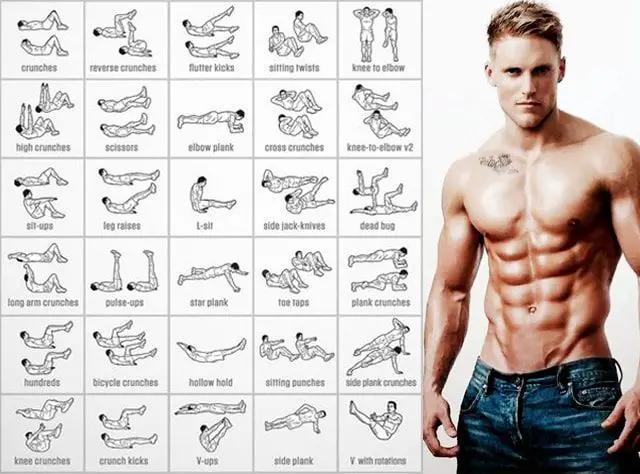Whatever your ab conditioning goal, there is a lot of information and misinformation about training this particular area. In this article we are acknowledging that realistically, it depends on you and your goals. Everyone is different and we have to remember, what works for some won’t work for others.
A lean and well-defined six-pack is as much a product of nutrition as it is exercise. For men, this normally means body fat levels of 10% or less and 16% or less for women. So make sure that, along with your ab training routine, your diet is in order too.
You also need to consider your choice of exercises. Crunches, sit ups and other spinal flexion exercises are fine but as your spine moves in a variety of directions, you need to select a variety of exercises if you want to maximise your abdominal development.

If you can do 20 or more reps of an ab exercise, chances are it is too easy. When selecting ab training exercises, train using demanding exercises that keep your repetitions below 20 per set.
Here are a few options to consider:
All other factors aside, any ab workout is better than no workout. With a strong core, you build a strong foundation for daily activities.
Everyday motions like bending, turning around, sitting, and standing are benefited by strong ab muscles, as are more intense activities like playing a sport, moving out of your apartment, or going on a long bike ride.
Any ab exercise is better than none at all, so don’t let the time of day keep you from pursuing stronger abs.
Ab training at the end of your strength or cardio workout:
Most of the people train their core at the end of their usual routine. There are some advantages of this. Firstly, your muscles, mainly your lower back, is already warmed up, so you can avoid injuries or strains.

The other benefit is that typically abdominal exercises are not as hard as the compound ones like dead lifts or squats, this way we still have enough energy for ab training. However, this greatly depends on the activities you do. If you want to do numerous hanging leg raises or exercises with dumbbells in the end, you will need far more power.
A disadvantage might be that since we are already tired, we are more willing to neglect the training.
The main advantage of performing your ab exercises last is that, in terms of energy expenditure, ab exercises are easier than compound exercises. This means that despite having worked hard, you should still have sufficient energy left to finish your workout with some effective ab exercises.
Ab training during your strength or cardio workout:
This is what I do these days. I’m pretty satisfied with my other muscles groups, but not with my core, I want to pay more attention to it. Consequently, I perform harder core exercises which require more strength.

Working the abs during the workout has another benefit. Let’s say you have an arm day and you strengthen your biceps and triceps. You maybe do dips, dumbbell curls, etc. Between each set you do some abdominal movements such as planks, crunches, leg raising, etc. And you have only short rests between the sets.
This will raise your heart rate and force your body to burn more calories. This way you will be able to burn fat as well which is vital to build a lean midsection.
If your aim is to get six pack abs, I recommend you taking this method. However, you may have less power to perform the other non-core moves.
A great way to get plenty of ab work done in a very time efficient way is to perform your ab exercises during your breaks from your main exercises; for example by doing a set of planks between sets of pull downs.
This makes your workout much more time efficient and also ensures your heart rate stays elevated throughout your workout. As well as being time efficient, this is also a great way to burn more calories
Ab training at the beginning of your strength or cardio workout:
To tell the truth, I do this rarely. The reason is that I used to have lower back pain because I did not spend enough time on warming up. If you begin your routine with core exercises, it is critical to warm up and stretch before you start.

The advantage of this method, if you do it correctly, is maybe that your spine and lower back is already warmed when you start doing your strength training. This helps to avoid injuries and strains.
Ab exercises generally involve movement of your spine. By doing some ab work near the beginning of your workout, you loosen up and mobilise your spine which can help make sure your back is thoroughly warmed up before you begin your main workout.
On the downside, overusing your abs early in your workout can reduce spinal stability for safe performance of key exercises such as squats and deadlifts so although this is a viable option for some exercisers.
Ab training on a separate day to your main workouts:
This method is the best for those who want to focus the most on their midsection. Since, we do not need to work the other body parts, we can perform a harder, more complex and longer abdominal routine.

If you have a training on a separate day, you will be able to do tougher moves for your midsection and ones which will raise your heart rate.
So for the question “What is the best time to work my abs?”, my answer is it depends on your aims. If you want to flatten your tummy faster having workouts on a separate day or during your general routines is the best solution. If not, I recommend doing them in the end.
This is a great option if you are serious about your ab work. Squeezing in ab work before or after your main session is okay but time and energy can be limiting factors. Dedicating a couple of mini-training sessions per week to your abs can:
- Leave you with more time for your main workouts.
- Allow you to concentrate 100% on developing your abs.
If you choose to do this, make sure you spend a couple of minutes warming up before your ab workout to ensure that you minimise your risk of injury.
In summary, there is more than one “best time” for ab training – it very much depends on what you need and what you think is best for you.

